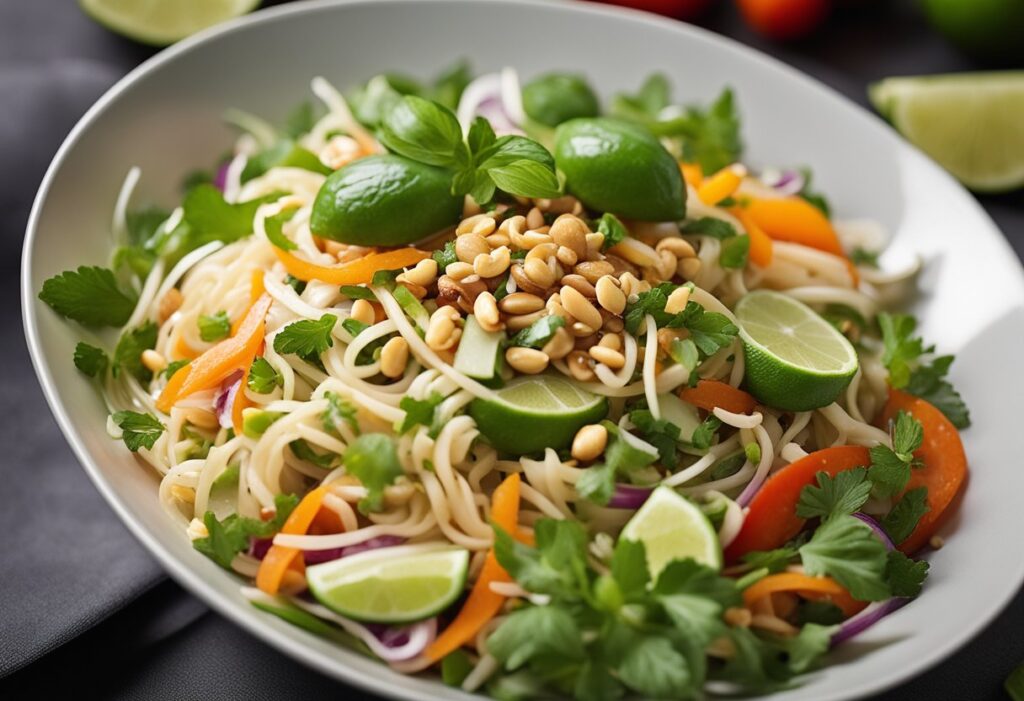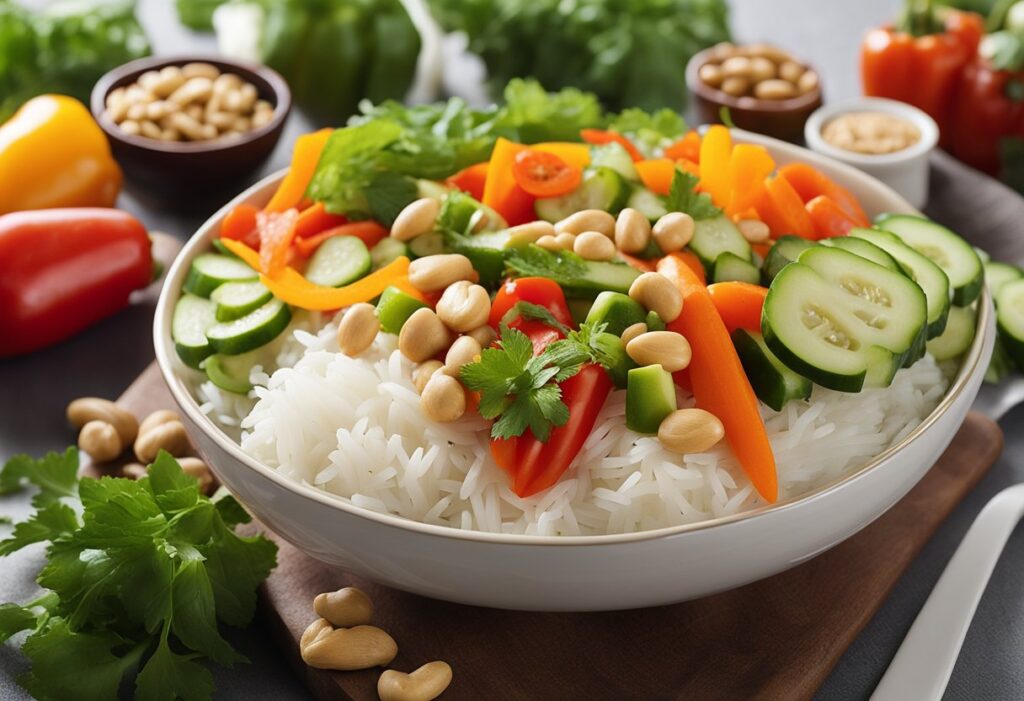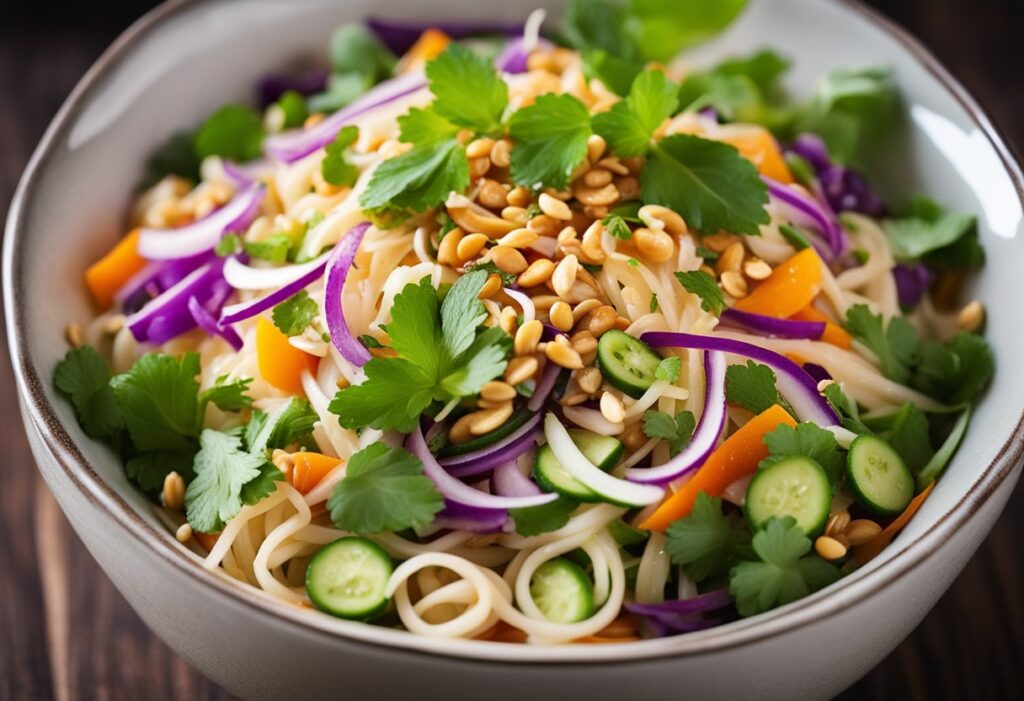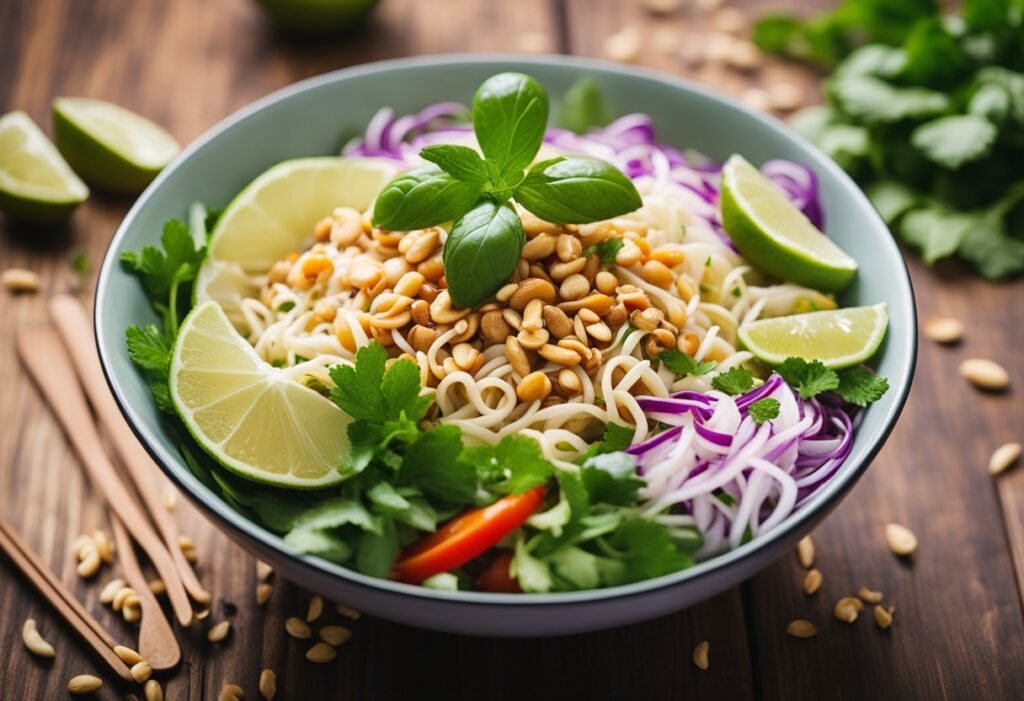Thai noodle salad is a refreshing and flavorful dish that is perfect for any occasion. This dish is a popular Thai street food that has gained popularity all over the world due to its unique flavor profile and simplicity. It is a perfect dish for those who are looking for a healthy and delicious meal that can be prepared in a short amount of time.
Table of Contents

The dish is made up of rice noodles, fresh vegetables, and a flavorful dressing that is made up of lime juice, fish sauce, and chili. The combination of these ingredients creates a perfect balance of sweet, sour, and spicy flavors that are sure to tantalize your taste buds. The dish can be customized to suit your taste preferences by adding or subtracting ingredients as per your liking.
Overview of Thai Noodle Salad
Cultural Significance
Thai noodle salad is a dish that is commonly found in Thailand, and it is often served as a light meal or a snack. The dish is known for its refreshing flavors and textures, which are a result of the combination of fresh vegetables, herbs, and noodles.
The dish is believed to have originated in the northeastern region of Thailand, where it is known as “Yam Wun Sen.” It is a popular dish in Thai cuisine and is often served at restaurants and street food stalls.
Dish Variations
There are many variations of Thai noodle salad, and the ingredients used can vary depending on the region and the cook’s preference. Some variations may include shrimp, chicken, or tofu, while others may have a spicy or sweet dressing.
One popular variation of Thai noodle salad is the “Pad Thai” noodle salad, which includes rice noodles, peanuts, bean sprouts, and a sweet and sour dressing.
Another variation is the “Som Tum” noodle salad, which includes green papaya, carrots, and peanuts, and is dressed with a spicy and sour dressing.
Overall, Thai noodle salad is a versatile dish that can be customized to suit different tastes and preferences. It is a healthy and flavorful dish that is perfect for a light meal or a snack.
Essential Ingredients

Noodle Types
Thai noodle salad is typically made with thin rice noodles, also known as rice vermicelli. These noodles are gluten-free and have a delicate texture that absorbs the flavors of the other ingredients in the dish. Other noodle options include wheat noodles, glass noodles, or even spiralized vegetables for a low-carb option.
Vegetables and Herbs
The vegetables and herbs used in Thai noodle salad add color, texture, and flavor to the dish. Common options include shredded carrots, sliced cucumbers, chopped cilantro, and thinly sliced red onions. Bean sprouts, bell peppers, and shredded cabbage can also be used.
Protein Options
Protein is an important component of Thai noodle salad. Grilled chicken, shrimp, or tofu are popular options. For a vegetarian option, roasted peanuts or cashews can be added for crunch and protein.
Dressing Components
The dressing for Thai noodle salad typically includes a combination of sweet, sour, and spicy flavors. Fish sauce, lime juice, and rice vinegar are common ingredients. Sugar or honey can be added for sweetness, while chili paste or chopped Thai chilies can add heat. Garlic, ginger, and lemongrass can also be used for additional flavor.
Step-by-Step Recipe

Preparation of Ingredients
Before starting with the recipe, gather all the necessary ingredients in one place. For the Thai noodle salad recipe, you will need the following ingredients:
- Rice noodles
- Carrot
- Cucumber
- Bell pepper
- Red onion
- Fresh cilantro
- Roasted peanuts
- Lime wedges
Wash and chop all the vegetables into thin slices. Soak the rice noodles in hot water for 10-15 minutes or until they become soft. Drain the water and rinse the noodles with cold water. Keep all the ingredients aside for further use.
Cooking Noodles
Boil 6 cups of water in a large pot and add the soaked and rinsed rice noodles to it. Cook the noodles for 3-4 minutes or until they become tender. Drain the water and rinse the noodles with cold water. Keep the noodles aside for further use.
Mixing the Salad
In a large mixing bowl, combine the cooked rice noodles, chopped vegetables, and roasted peanuts. Mix everything well using a pair of tongs or a fork. Add fresh cilantro leaves and mix again.
Dressing Preparation
In a small mixing bowl, whisk together the following ingredients to make the dressing:
- 3 tablespoons of fish sauce
- 2 tablespoons of lime juice
- 1 tablespoon of honey
- 1 tablespoon of sesame oil
- 1 garlic clove, minced
- 1 red chili, thinly sliced
Whisk everything well until the dressing becomes smooth and creamy.
Final Steps
Pour the dressing over the mixed salad and toss everything well. Divide the salad into individual serving bowls and garnish with lime wedges and extra peanuts. Your delicious Thai noodle salad is ready to serve.
Serving Suggestions

To elevate the flavors of the Thai noodle salad, there are several serving suggestions that can be followed. First and foremost, it is recommended to serve the salad chilled to enhance its refreshing taste and texture.
For a more filling meal, the salad can be served with grilled chicken, shrimp, or tofu on top. This adds protein to the dish and complements the flavors of the salad.
To add crunch and texture, chopped peanuts or cashews can be sprinkled on top of the salad. This also adds a nutty flavor that pairs well with the other ingredients.
For a spicier kick, sliced red chili peppers or a drizzle of Sriracha sauce can be added to the salad. This adds heat and depth of flavor to the dish.
To make the salad more visually appealing, it can be served in a large bowl or platter with the ingredients arranged neatly on top. This also makes it easier for guests to serve themselves.
Overall, these serving suggestions can help enhance the flavors and presentation of the Thai noodle salad, making it a delicious and satisfying meal.
Nutritional Information
The Thai noodle salad recipe is a healthy and nutritious dish that is loaded with essential nutrients. This salad is a great source of vitamins, minerals, and fiber. Here are some of the key nutritional benefits of this dish:
Calories
A serving of Thai noodle salad contains approximately 350-400 calories, depending on the ingredients used. This makes it a great option for those who are looking to maintain a healthy weight.
Protein
The salad is a good source of protein, which is essential for muscle growth and repair. The protein in this dish comes from the chicken or tofu, as well as the peanuts.
Carbohydrates
The noodles in this salad are a good source of carbohydrates, which are the body’s primary source of energy. The vegetables in the salad also provide additional carbohydrates and fiber.
Fat
The salad contains healthy fats from the peanuts and the dressing. These fats are important for brain function, hormone production, and overall health.
Vitamins and Minerals
The Thai noodle salad is loaded with vitamins and minerals, including vitamin C, vitamin A, iron, and calcium. These nutrients are essential for maintaining a healthy immune system, strong bones, and healthy skin.
Overall, the Thai noodle salad is a healthy and nutritious dish that is easy to prepare and delicious to eat. It is a great option for those who are looking to eat healthier and maintain a balanced diet.
Allergy and Dietary Considerations
When making a Thai noodle salad, it is important to consider any dietary restrictions or allergies that you or your guests may have. Here are some common allergens and dietary considerations to keep in mind:
Gluten-Free Options
For those who are gluten intolerant or have celiac disease, it is important to use gluten-free noodles in the recipe. Rice noodles are a great option for those who cannot tolerate gluten. Additionally, be sure to use gluten-free soy sauce or tamari in the dressing.
Nut-Free Options
If you or your guests have a nut allergy, it is important to omit any nuts from the recipe. Instead, try using seeds such as pumpkin or sunflower seeds for added texture and flavor.
Vegetarian and Vegan Options
To make this recipe vegetarian or vegan, simply omit the chicken and use a vegetarian or vegan protein such as tofu or tempeh. Additionally, be sure to use a vegetarian or vegan fish sauce or omit it altogether.
Allergen Cross-Contamination
It is important to avoid cross-contamination with allergens when preparing this dish. Be sure to thoroughly clean all utensils and equipment before preparing the meal. Additionally, it may be helpful to prepare the dish in a separate area of the kitchen to avoid any cross-contamination.
By keeping these dietary considerations in mind, you can ensure that everyone can enjoy this delicious Thai noodle salad.
Storage and Leftovers
After enjoying the delicious Thai noodle salad, it’s important to store the leftovers properly to maintain its freshness and flavor. Here are some tips on how to store and reheat the Thai noodle salad:
- Store the salad in an airtight container in the refrigerator. It can last up to 3-4 days if stored properly.
- Do not mix the dressing with the salad until you are ready to serve. This will prevent the noodles from becoming soggy and the vegetables from losing their crunchiness.
- If you want to make the salad ahead of time, you can prepare the ingredients separately and store them in separate containers. Mix them together with the dressing just before serving.
- To reheat the salad, you can microwave it for 1-2 minutes or until it’s warm. Alternatively, you can heat it up in a pan over medium heat for a few minutes. Do not overheat the salad as it can become mushy.
- If the salad looks dry after storing it in the refrigerator, you can add a little bit of dressing or lime juice to freshen it up.
By following these simple tips, you can enjoy the Thai noodle salad for a few days after making it. It’s a great way to save time and enjoy a healthy and flavorful meal anytime you want.

